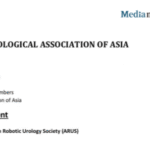
Professor Xinan Sheng Discusses a New Era of Individualized Management — Driving Therapeutic Upgrades with Novel Combination Therapies and Precision Stratification
Editor’s Note: On August 22–23, 2025, the highly anticipated 2025 Pujiang Uro-Oncology Conference was held in Shanghai, gathering leading experts in urologic oncology from across China and abroad. Among the key topics was the optimization of treatment strategies for metastatic hormone-sensitive prostate cancer (mHSPC). Professor Xinan Sheng from Peking University Cancer Hospital delivered an insightful lecture titled “The Combination Revolution in mHSPC — Multi-Strategy Optimization of Patient Management.” His talk provided a systematic review of the current treatment landscape, key challenges, and future directions for mHSPC management.Prostate Cancer in China: Current Status and Challenges
Professor Sheng began by highlighting that prostate cancer has become one of the most common urologic malignancies in China. In major cities such as Beijing, Shanghai, and Guangzhou, prostate cancer now ranks second or third among male malignancies. According to data released by the National Cancer Center, the incidence of prostate cancer has risen rapidly, now approaching the combined incidence of kidney cancer and urothelial carcinoma, making it one of the top ten cancers nationwide.As China enters an aging society, prostate cancer — a disease that predominantly affects older men — poses an increasingly serious public health challenge.Currently, the majority of Chinese patients are diagnosed at a metastatic stage, with mHSPC accounting for approximately 54% of all first diagnoses. Some patients even present with metastatic lesions as the first clinical manifestation. However, with improving public awareness and the promotion of early screening, this trend is gradually changing. Professor Sheng cited data showing that, compared with ten years ago, the number of radical prostatectomies performed annually at major Chinese medical centers has risen from just over 100 to well over 1,000, with expectations that the proportion of late-stage diagnoses will drop to around 30%. This shift is anticipated to drive a significant improvement in overall five-year survival.
Nevertheless, five-year survival for metastatic prostate cancer remains among the lowest for male malignancies, and the disease is still considered “incurable.” The main therapeutic goals remain prolonging survival and improving quality of life. In addition, delaying the progression from mHSPC to metastatic castration-resistant prostate cancer (mCRPC) has become a crucial treatment objective, underscoring the need for optimized therapeutic strategies.
Evolving Treatment Concepts and Multi-Dimensional Goals
Professor Sheng emphasized that prostate cancer management has entered a “new era.” Rapid drug development has transformed classification from the traditional “hormone-dependent vs. hormone-independent” model to a more precise distinction between “hormone-sensitive vs. castration-resistant prostate cancer (CRPC).”
Whereas treatment options in the hormone-sensitive stage were once limited, multiple therapeutic agents have now been moved into earlier lines of treatment, significantly enriching available strategies. The pace of therapeutic innovation continues to accelerate, with endocrine therapy, chemotherapy, targeted agents, immunotherapy, and even radionuclide therapy all now widely used in prostate cancer care. Professor Sheng also noted that teams are actively exploring CAR-T cell therapy for prostate cancer, suggesting that future treatment models will become even more diverse.
Breakthroughs in the Era of Combination Therapy and the Need for Precision Stratification
Over the past two decades, mHSPC treatment has shifted dramatically from single-agent androgen deprivation therapy (ADT) to combination therapy. Landmark trials such as STAMPEDE and LATITUDE demonstrated significant survival benefits with ADT plus chemotherapy or ADT plus novel androgen receptor-targeted agents (ARATs). More recently, triple therapy regimens combining ADT, ARATs, and docetaxel have marked the arrival of a new era of multi-agent treatment.
However, Professor Sheng cautioned that not all patients are suitable candidates for intensified combination therapy. The phenomenon of “different outcomes for the same disease” is particularly evident in prostate cancer. Some patients, particularly older ones, can live stably for years on endocrine therapy alone, while others experience rapid progression.
Clinical practice typically stratifies patients by tumor burden (“low-volume” vs. “high-volume”) or by risk (“low-risk” vs. “high-risk”). For patients with relatively indolent biology and lower tumor burden, treatment can be kept relatively minimal (“less is more”). In contrast, patients with high tumor burden derive greater benefit from intensified combination regimens. Today, ADT plus a novel ARAT is generally considered the preferred strategy for lower-burden mHSPC, while triple therapy is favored for those with higher tumor burden.
Looking ahead, Professor Sheng predicted that over the next 5–10 years, the current “low-volume/high-volume” classification will evolve into more refined, biomarker-driven stratification strategies. Early identification of high-risk patients through biomarkers could enable intervention before the onset of widespread or visceral metastases, achieving a truly “tailored” therapeutic approach.
Bone Metastasis Management and ADT Selection
Bone metastases are a hallmark of mHSPC, with bone pain being the second most common presenting symptom after lower urinary tract obstruction. Professor Sheng emphasized that 70–80% of mHSPC patients develop bone metastases. Importantly, systemic treatment of prostate cancer bone metastases is among the most effective in solid tumors, comparable to the treatment success seen in multiple myeloma.
However, bone metastases are often associated with severe skeletal-related events (SREs), including paralysis due to spinal cord compression. Prompt and effective suppression of testosterone is therefore a priority to relieve symptoms and improve quality of life.
Professor Sheng noted that traditional GnRH receptor agonists can initially cause a transient testosterone surge, leading to “tumor flare” — worsening bone pain or even precipitating spinal cord compression, particularly in patients with vertebral lesions. In contrast, GnRH receptor antagonists such as degarelix directly lower testosterone without causing flare, maintain sustained suppression of alkaline phosphatase, reduce the risk of disease progression and SREs, and provide rapid relief of lower urinary tract symptoms and pain.
Future Outlook and Contribution to the Field
In conclusion, Professor Sheng stated that while remarkable progress has been made in prostate cancer diagnosis and treatment in recent years, the field also faces unprecedented challenges. Emerging therapies such as targeted agents and radionuclide therapy have shown promising results, and biomarker-based stratification will continue to make treatment more complex yet more precise.
He expressed confidence that with deeper mechanistic research and accelerating technological innovation, there is tremendous potential for new discoveries in prostate cancer management. The discussions at this conference not only provided new insights for clinical practice but also brought together the collective wisdom of China’s leading urologic oncologists, driving the field toward a more precise and efficient future.


